
 Shiraz
Shiraz
Removed from Unnamed collection
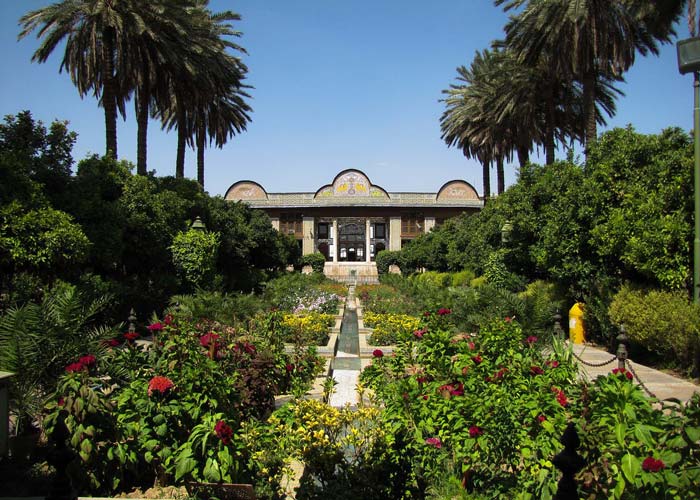
Removed from Unnamed collection
Bagh-e Narenjestan 
Bagh-e Narenjestan (or Qavam House) is a historical house in the city of Shiraz. Construction of the house dates back to late 19th century (Late Qajar era), belonging to the famous wealth family of Qavam in Shiraz. Qavam House is one of Shiraz tourist attractions for its beautiful garden of sour oranges and exquisite architecture.
While walking in the alleys of Shiraz, the smell of bitter orange intoxicates you. Now imagine wandering in the garden of bitter orange: Bagh-e Narenjestan! Bagh-e Narenjestan Shiraz or Narenjestan Garden Shiraz is famous for its bitter oranges and also the great mansions inside it. Narenjestan Shiraz is a must-visit to truly appreciate what makes Shiraz so famous among people. https://irantourismer.com/bagh-e-narenjestan/
Map
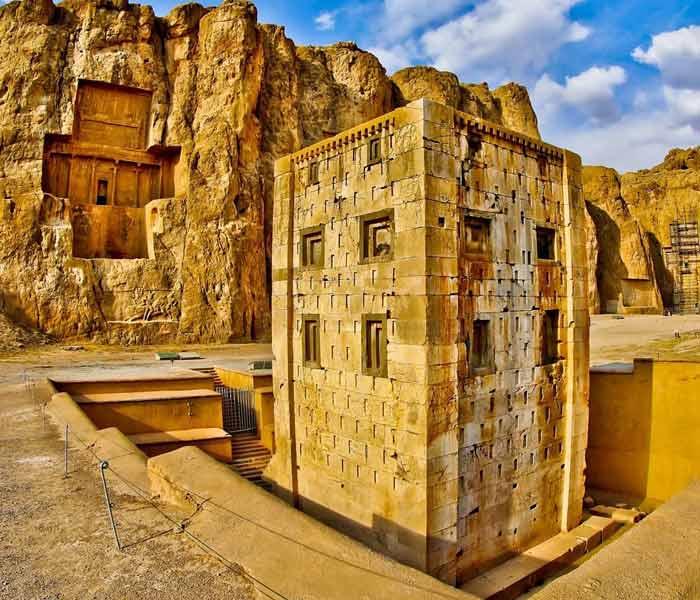
Removed from Unnamed collection
Naqsh-e Rustam 
Naqsh-e Rustam is an ancient necropolis, located near Persepolis and 68 km northeast of Shiraz city. Naqsh-e Rustam Shiraz is the necropolis of the Achaemenid Dynasty (550–330 BC) and contains rock-reliefs from the Sassanid era (224–651 AD). Naghsh-e Rostam counts as one of the top Shiraz attractions, paired with Persepolis.
A historic treasury lies in the Naqsh-e Rustam tombs location. Naghshe Rostam Shiraz is where the tomb of Darius I is located. According to the Naqsh-e Rustam inscription, archaeologists have discovered which great kings reside in Naqsh e Rustam burials. Inside Naqsh e Rustam tombs lacks any special design, however, there are carved the Naqsh-i Rustam inscriptions on the façade. Naghshe Rostam relief is like an ancient family album of the Achaemenids. https://irantourismer.com/naqsh-e-rustam-tomb-of-darius/
Map
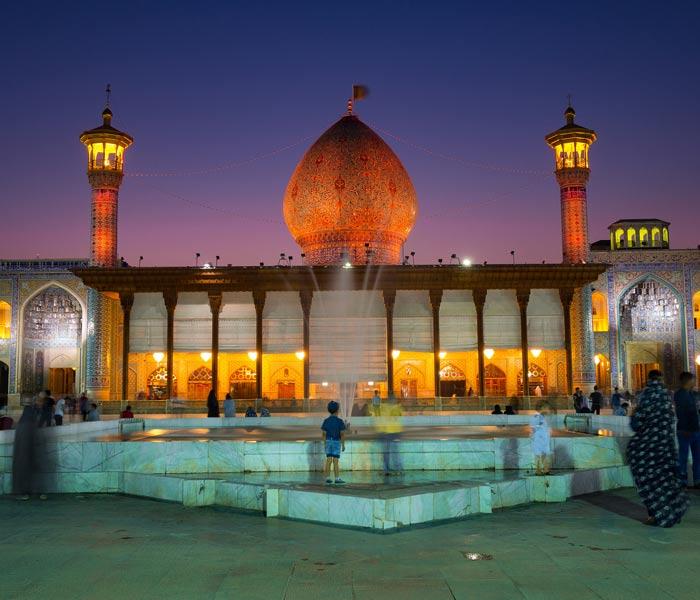
Removed from Unnamed collection
Shah Cheragh 
Shah Cheragh Shiraz (in Persian: King of Light) is one of the most popular funerary monuments in Iran. It is home to tombs of Ahmad and Mohammad, two brothers of Ali ar-Ridha – 8th Imam of Shia Muslims. Circa 900 A.D, the two brothers aiming to join Ali ar-Ridha, who at the time resided in Khorasan of Iran (in eastern Iran) as the appointed successor to Abbasid caliph, took refugee in Shiraz but were persecuted by the Abbasids.
The tombs remained unknown until early 12th century A.D. Different accounts or myths exist around the discovery of the tombs; All of which revolve around noticing a luminous light in the distance, where later the gravesites were discovered. And this is basically the reason behind the appellation: ‘’King of Light’’ or Shah Cheragh Mausoleum. https://irantourismer.com/shah-cheragh-shiraz/
Map
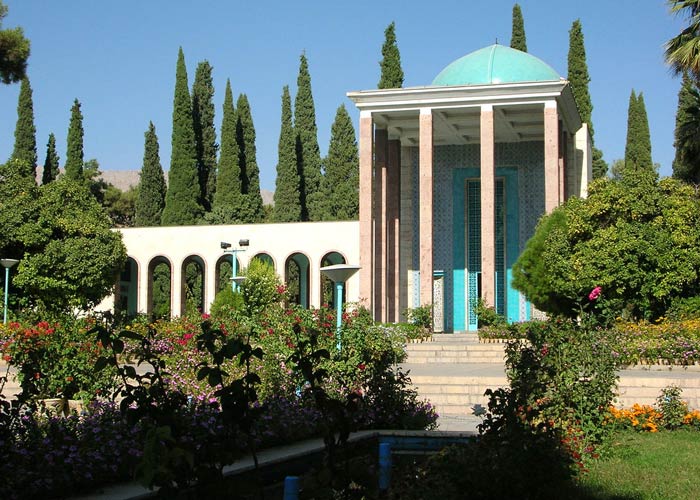
Removed from Unnamed collection
Tomb of Saadi 
Tomb of Saadi: The Tomb of Saadi is also called Saadieh. The first mausoleum was built in 13th century, however, it faced destruction in 17th century. The building that tourists visit today is the heritage of 1950s. The present building, which its architect was Mohsen Foroughi, was inspired by Chehel Sotun of Esfahan. Moreover, a Sassanid-year-old garden, the gorgeous Delgosha Garden is near the Tomb.
The Tomb of Saadi was a Khangah* where Saadi lived the final days of his life there. And so he was buried there. Inside the mausoleum, the verses of Saadi poems are inscribed all around the walls. https://irantourismer.com/saadi-tomb/
Map
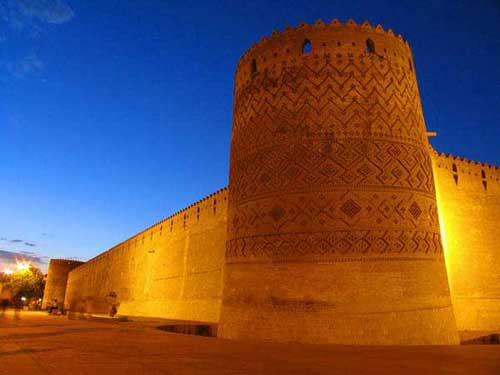
Removed from Unnamed collection
Arg of Karim Khan 
Once a formidable prison, the citadel now stands as an architectural marvel open for all to admire. This fascinating structure seamlessly blends military and residential designs. It was not only the stronghold of Karim Khan but also the military hub of its era. Located in the heart of Shiraz, the citadel draws visitors with its unique historical charm. The walls tell stories of the past, while the intricate details of its architecture captivate the imagination. Exploring the citadel is like stepping back in time, offering a glimpse into the life and times of those who once lived and governed there.
Map
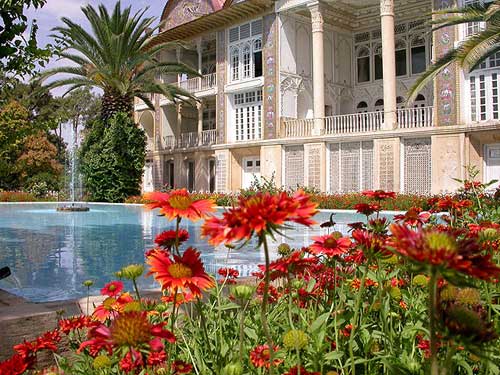
Removed from Unnamed collection
Eram Garden 
Eram Garden, also known as Bagh-e Eram, is an absolute must-see. This breathtaking oasis boasts a sprawling network of lush gardens, a vibrant palace, and a series of charming artificial rivers weaving through the landscape. The gardens are meticulously maintained, with an array of exotic plants and fragrant blossoms that create an atmosphere of tranquility and beauty. The palace, with its intricate tile work and stunning architecture, stands as a testament to the region's rich history. It's a place where you can easily spend an afternoon wandering, lost in the harmonious blend of nature and artistry. Be sure to take a moment to relax by the rivers; the gentle sound of flowing water adds to the garden's serene ambiance. For those who love photography, Eram Garden offers countless opportunities for stunning shots, particularly during the golden hours of sunrise and sunset.
Map
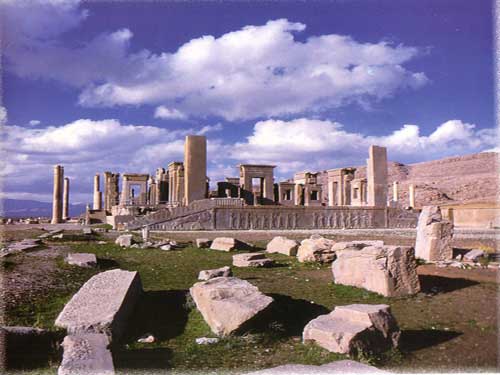
Removed from Unnamed collection
Persepolis 
When you're in Shiraz, you absolutely can't skip a visit to Persepolis. This stunning site is an essential part of any Shiraz itinerary, thanks to its breathtaking beauty, impressive grandeur, and rich history. As one of the major tourist attractions in Shiraz, Persepolis stands as a testament to the magnificence of the Persian Empire. Located in the heart of what was once the Persian Empire, it served as the ceremonial capital of the Achaemenian dynasty. You'll find Persepolis in the Fars province, about 60 kilometers from Shiraz, close to the city of Marvdasht. For those interested in history, Persepolis offers a captivating glimpse into ancient times. Imagine walking through the ruins where kings once celebrated Nowruz, the Persian New Year, with grand festivities. The intricate carvings and towering columns tell stories of a civilization that thrived over 2,500 years ago. It's more than just a historical site; it's a place where the past feels incredibly alive and vivid. A visit here is like stepping back in time, offering a unique opportunity to connect with an ancient culture that has influenced the world in countless ways.
Map
Explore more places related to this search:
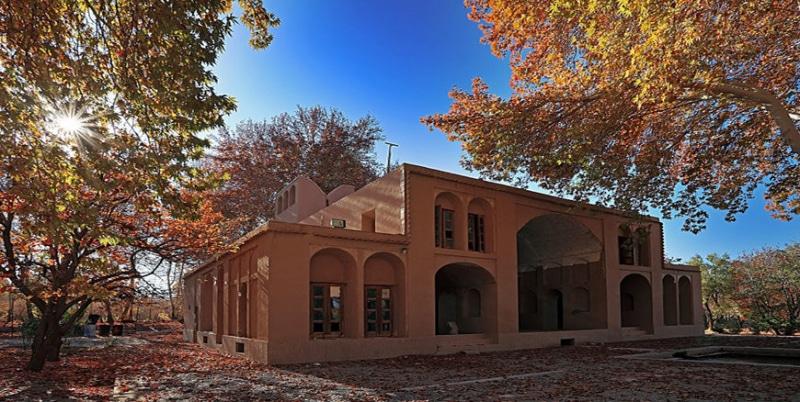
Removed from Unnamed collection
Pahlavanpour Garden 
Pahlavanpur garden is one of the well-known and historical orchards of Iran. The orchard manifests Iranian and traditional architecture and has an eye-catching landscape. Located in Mehriz city, the orchard covers an area of roughly 5 hectares which is dated to Qajar era. Although the orchard was constructed in Qajar era, the hallmarks of the architectural styles, belonging to Zand dynasty are evident in different parts of this orchard.
Historical buildings in this orchard have created a special bond between the nature and the art of architecture. The orchard includes a summerhouse, a winter quarter, janitor’s unit, the public bathroom and the kitchen Its architectural style is a blend of the architectural style of the summerhouse and the central courtyard. http://yazd.today/pahlavanpour-garden/
Map
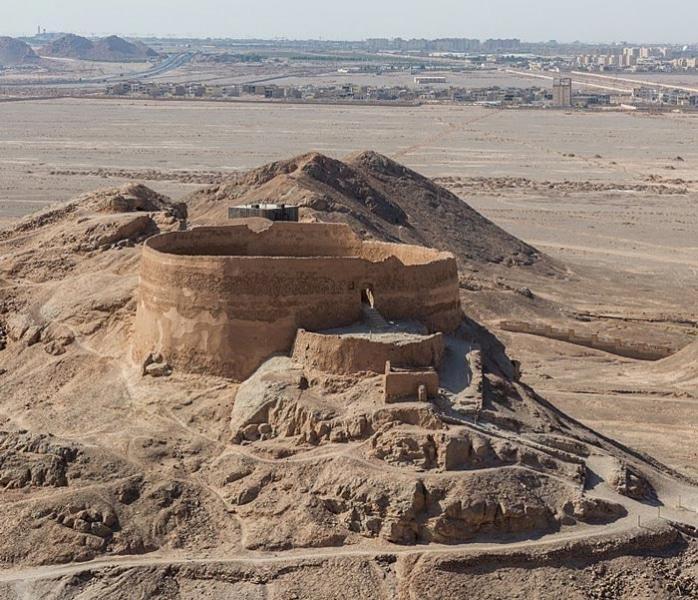
Removed from Unnamed collection
Zoroastrian Towers of Silence 
Towers of Silence in Yazd city are raised circular structures where Zoroastrians would leave the dead bodies to deflesh since ancient times. As one of the main Yazd attractions, no tourist affords to miss a visit to the daunting Towers of Silence.
Now, Where is the Tower of Silence? Well-preserved Zoroastrian Towers of Silence are found in Yazd, which is home to the majority of Zoroastrian community in Iran. Towers of Silence offer visitors an unmissable story behind Zoroastrian beliefs, on top of all, the answer to the much asked question: What did Zoroastrians do with dead bodies and why?
Towers of Silence (or Dakhma) were constructed atop hills or low mountains in desert locations distant from population centers.
Today, the only extant towers of Silence are found in Iran (cities like Yazd, Kerman, Shiraz, …) and India, where Parsi communities exist. https://irantourismer.com/towers-of-silence/
Map
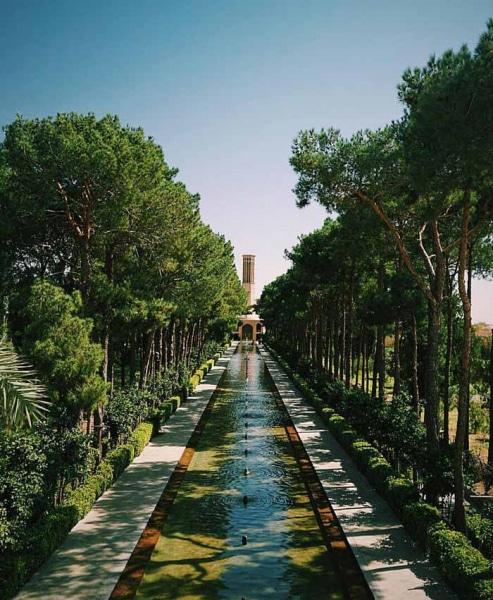
Removed from Unnamed collection
Dolat Abad Garden 
Dolat Abad Garden: Imagine a hot sandy desert. Sun is up and you can feel the high-temperature rays in your every cell. Neither wind nor breeze. Nothing but heat. Are you ready for a miracle to put you at leisure? Are you ready to get cool and relaxed? Dolat Abad Garden (Dowlat Abad Garden) is somewhere you’re looking for!
Generally, the Persian garden style is a really unique one indeed. UNESCO has listed 9 of the Persian gardens of Iran and Dolat Abad Garden is one of them.
The moment you enter the gate you are astonished with the nature you didn’t expect to see. A manmade waterway with small fountains, walled with tall trees leading you to the pavilion in the middle of the garden.
As you walk down the path you can feel the cool breeze touching your skin and the shade of trees relieving you from the burning sun. We hope that you are feeling better than those heaty moments before entering the Dolat Abad Garden. https://irantourismer.com/dolat-abad-garden-in-yazd-bagh-e-dowlat/
Map
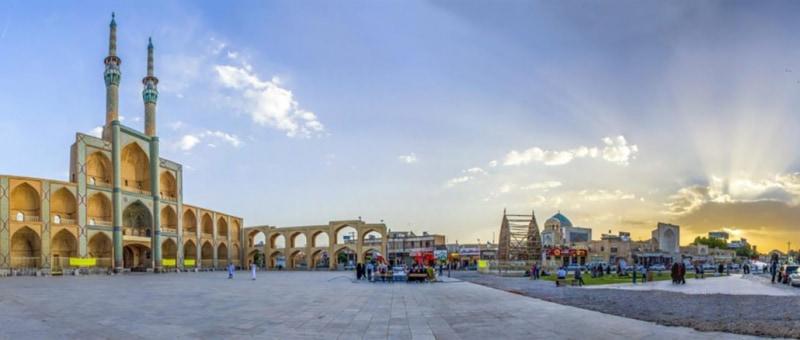
Removed from Unnamed collection
Amir Chakhmaq Complex 
The 19th-century Amir Chakhmaq Complex with its imposing three-story facade is one of the abundant tourist hotspots of Yazd, an oasis city in central Iran. Located on a square of the same name, the prominent complex is noted for its eye-catching rows of symmetrical sunken alcoves, which are perfectly lit up following the sunset.
The structures that make up the complex include a mosque, a caravanserai, a bathhouse, a cold-water well and a tekyeh where Shiite Muslims come together for observing special religious ceremonies, all of which have been designed in accordance with traditional layout principles.
The perfectly proportioned niches on the façade may seem at their best and most photogenic late in the afternoon, when towering exterior appears to glow against the darkening sky and copper-coloured sunlight is captured within each alcove.
A pedestrianized square overlooking the complex is usually full of visitors. It is landscaped with a vast pool, illuminated fountains, well-manicured trees and shrubs that lend an attractive foreground to the splendid vista at night. http://yazd.today/yazd-amir-chakhmaq-complex-is-a-photogenic-destination-for-thousands-of-tourist/
Map
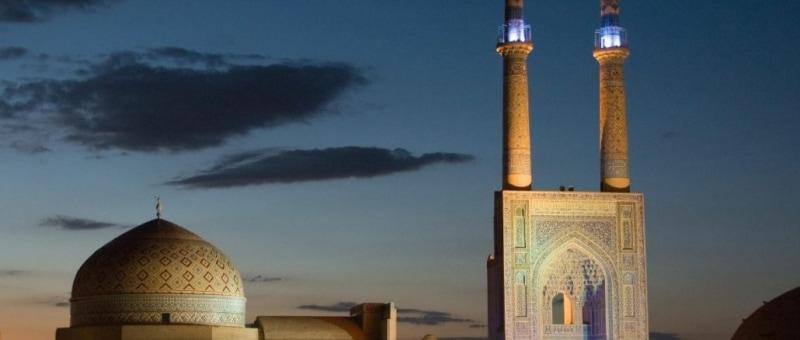
Removed from Unnamed collection
Yazd Masjid-e-Jameh 
The Masjid-e-Jameh Yazd is the grand, congregational mosque of Yazd city. The 12th-century mosque is still in use today. It was first built under Ala’oddoleh Garshasb of the Al-e Bouyeh dynasty. The mosque was largely rebuilt between 1324 and 1365, and is one of the outstanding historical buildings of Iran.
The mosque is a fine specimen of the Azari style of Persian architecture. The mosque is crowned by a pair of minarets, the highest in Iran, and the portal’s facade is decorated from top to bottom in dazzling tile work, predominantly blue in colour. Within is a long arcaded courtyard where behind a deep-set south-east iwan is a sanctuary chamber (shabestan). This chamber, under a squat tiled dome, is exquisitely decorated with faience mosaic: its tall faience Mihrab, dated 1365, is one of the finest of its kind in existence.
The elegant patterns of brickwork and the priceless inscription of mosaic tiles bearing angular Kufic all create a sense of beauty. The main prayer niche, the one which is located below the dome, is decorated with elegant mosaic tiles.
On the two star-shaped inlaid tiles, the name of the builder and the time of construction of the prayer niche sparkle beautifully. The two towering minarets dating back to the Safavid era measure 52 meters in height and 6 meters in diameter. http://yazd.today/yazd-masjid-e-jameh-the-12th-century-mosque-one-of-the-most-interesting-historical-monuments/
Map
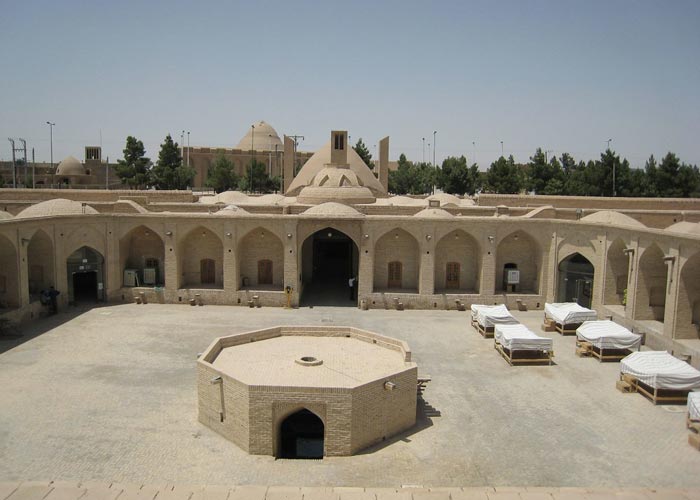
Removed from Unnamed collection
Shah Abbasi Caravanserai 
Meybod Caravanserai or popular as Shah Abbasi Caravanserai Meybod, built in 1689, sits in the city of Meybod, 56 km northwest of Yazd City. Properly preserved, Meybod Caravanserai is one of the numerous caravanserais of Iran, constructed in the Safavid era (1501-1726). It is neighbored by Kolar Water Reservoir (Ab Anbar) on its entrance, an Icehouse (Yakhchal) on its opposite, and a Pony Express (Chapar-Khaneh) on its side. Hence, Meybod sightseeing counts as one of the popular Yazd tourist attractions.
Caravanserais were constructed along the highly commuted Silk Road and major trade or pilgrimage routes throughout history. During the Safavid Era, especially the reign of Shah Abbas the Great, 5th and influential king of Safavid Dynasty, numerous caravanserais were established to facilitate commutes as part of their growing international trade and relations policy, and pilgrimage routes to/from religious cities.
Meybod Caravanserai, like its counterparts, did not just offer an austere place to stay the night, but it served travellers with full amenities such as equipped chambers and niches, freshwater access, animal stalls, etc. for a comfortable stay of several days. https://irantourismer.com/meybod-caravanserai/
Map
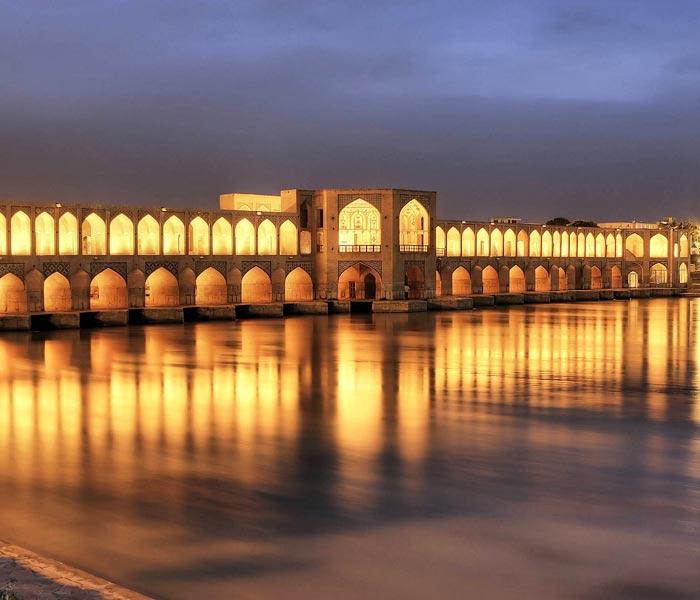
Removed from Unnamed collection
Si-o-se Pol Bridge 
Si-o-Se Pol Bridge (or Allahverdi Khan bridge) is the largest bridge among the 11 bridges in Isfahan city, which cross the river of Zayanderud, an of Isfahan tourist attractions. The bridge was built in early 17th century by the order of Safavid king, Shah Abbas I, to serve as a bridge and also a dam. The popular name Si o se Pol (lit. 33 bridge) comes from the structure of the bridge comprising of 2 superimposed rows of 33 arches.
The first thing that comes to mind about Isfahan city is probably the Si o se Pol bridge. All people in Iran know si-o-se pol bridge in Isfahan as its symbol (bridge of 33 arches Iran in English). Si-o-se Pol Isfahan Iran like other must-see places has a history behind it. https://irantourismer.com/si-o-se-pol-bridge-of-33-arches/
Map
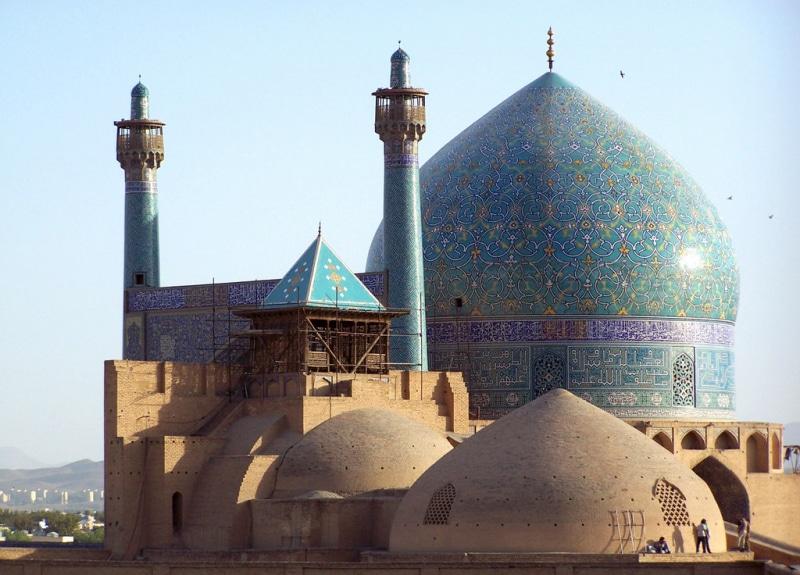
Removed from Unnamed collection
Imam Mosque 
Nestled on the southern side of Imam Square, also known as Naqsh-e Jahan, the construction of this magnificent mosque began in 1020 A.H. under the directive of Shah Abbas I, during the 24th year of his reign. The intricate decorations and expansions were completed by his successors. The brilliant minds behind this architectural marvel were chief architect Ostad Ali Akbar Isfahani and supervisor Moheb Ali Beik. This mosque is a stunning example of 16th-century craftsmanship, boasting exquisite architecture, intricate tile work, and masterful stone carving. One of the most captivating features is the echo effect in the center of its grand dome in the southern section. This dome towers at 52 meters high, with minarets reaching 48 meters. At the mosque’s entrance in Naqsh-e-Jahan Square, the minarets rise to 42 meters. The breathtaking one-piece marble and other stone slabs, along with the detailed tile work and decorations, offer a truly spectacular sight. As you step inside, you’re enveloped by a sense of history and artistry that’s almost tangible. The mosque's strategic placement in the bustling heart of the square makes it a focal point for both locals and travelers. This location also offers a perfect opportunity to explore the surrounding shops and cafes, where you can sip on a traditional Persian tea while soaking in the vibrant atmosphere.
Map
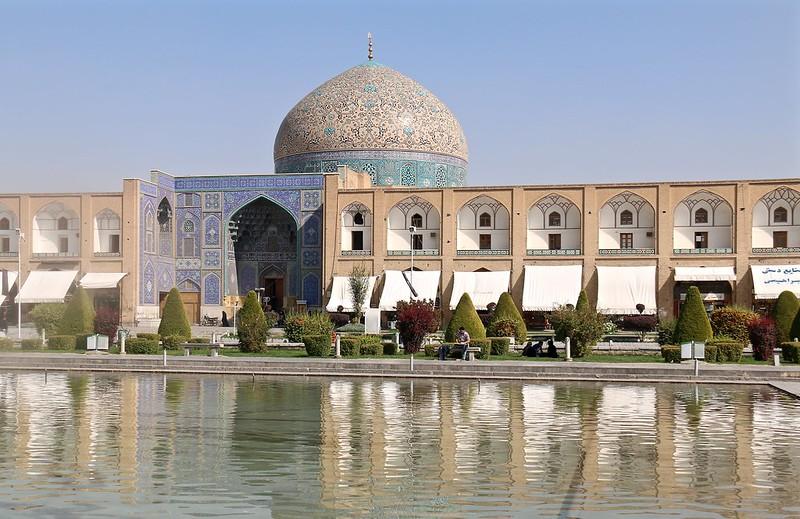
Removed from Unnamed collection
Sheikh Lotfollah Mosque 
Nestled in the heart of Isfahan, the Sheikh Lotfollah Mosque stands as a breathtaking testament to 16th-century architectural genius. This masterpiece, commissioned by Shah Abbas I, took 18 years to complete and was brought to life by the skilled hands of architect and mason Ostad Mohammad Reza Isfahani. The mosque's interior is a dazzling display of mosaic tiles that stretch from the plinth all the way to the ceiling. The intricate tilework is so stunning that foreign archaeologists have remarked, "It can hardly be considered a product of human hands." The mosque was constructed to honor Sheikh Lotfollah, a revered figure in the Shia sect from what we know today as Lebanon. Shah Abbas I invited him to Isfahan, where he led prayers and shared his teachings within these very walls. For those who visit, the mosque offers more than just architectural beauty. The serene atmosphere invites contemplation and reflection, making it a perfect spot to pause and soak in the rich history surrounding you. Don't miss the opportunity to explore the nearby Naqsh-e Jahan Square, a UNESCO World Heritage site, bustling with life and a perfect place to experience local culture and cuisine. It's these layers of history and culture that make Isfahan a truly unforgettable destination.
Map
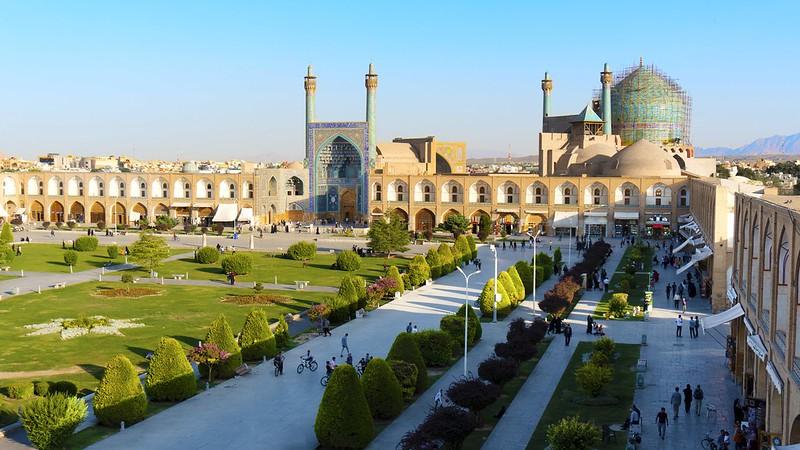
Removed from Unnamed collection
Naqsh-e Jahan Square 
Before Isfahan was crowned as the capital by the Safavid dynasty, Naqsh-e Jahan Square, which means "Image of the World," already held its place near what is now known as Imam Square. When Shah Abbas the Great took the throne, he expanded this square to nearly its current size and surrounded it with Isfahan's most iconic historical buildings. Spanning over 85,000 square meters, the square became a hub of activity during Shah Abbas I's reign and beyond. It hosted grand festivities, thrilling polo matches, dramatic performances, and impressive military parades. The square still boasts its original stone polo gates, standing proudly to the north and south. Stretching 500 meters from north to south and about 150 meters from east to west, Naqsh-e Jahan Square is often hailed by international visitors as one of the world's most spectacular squares. For over four centuries, it has been a silent witness to the rich tapestry of Iran's history. The square holds the echoes of Shah Abbas the Great's life and those of his successors, right up until the end of the Safavid era. Today, the square buzzes with life, filled with locals and tourists alike, marveling at its beauty and historical significance. It's a cultural melting pot where you can find traditional Persian handicrafts, taste delicious local delicacies, and soak in the vibrant atmosphere of Isfahan. Whether you're a history buff or just someone who appreciates stunning architecture, Naqsh-e Jahan Square is a must-see on any trip to Iran.
Map
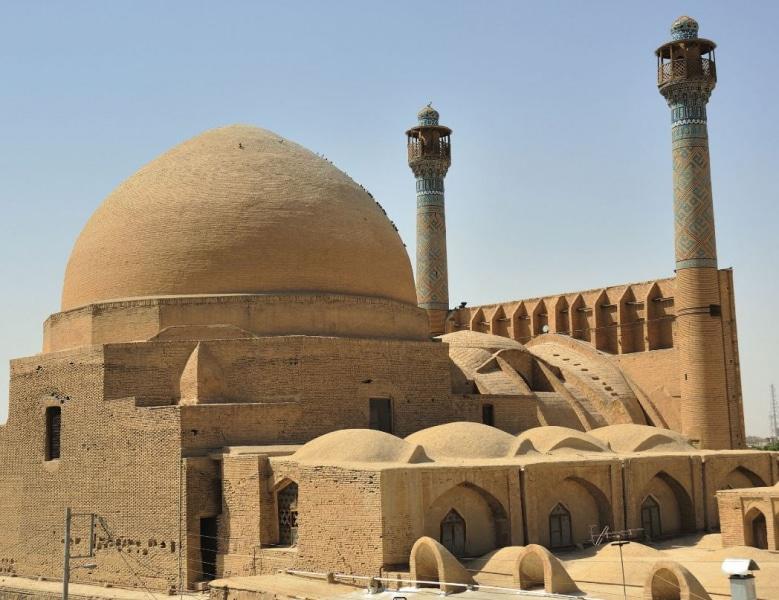
Removed from Unnamed collection
Juma Mosque 
Situated in the center of the city of Isfahan, the Juma Mosque is the most significant Seljuk monument in the city. Isfahan became the capital of the Seljuks, who came to Iran in the 11 th century. Adopting Sunni Islam, the Seljuks considered it an honour to repair the mosque, which was built by the Abbasid caliph. After the conquest of the city by Tughrul Beg, the Seljuks began an intense construction activity, and the Isfahan Masjidi Juma is the leading example of these efforts. The Seljuks did not conceive of the Masjidi Juma as an independent structure, but rather as an integral part of the urban plan. The Seljuks thus initiated the concept of the urban square, which would be further developed during the Safavid period. information from sources of the period relate the initial state of the building. Yakut Halevi states that when Tughril Beg conquered the city in 1051, the citizens of Isfahan forced him to destroy the building because of their need for wood Nasır; Husrev, who saw the mosque in 1052, describes its magnificent appearance. According to these sources, ft can be determined that the mosque was built in the Arabic or Kufa-type hypostyle mosque plan, as there were numerous wood bearing supports in place prior to the Seljuk period. http://www.selcuklumirasi.com/architecture-detail/juma-mosque
Map
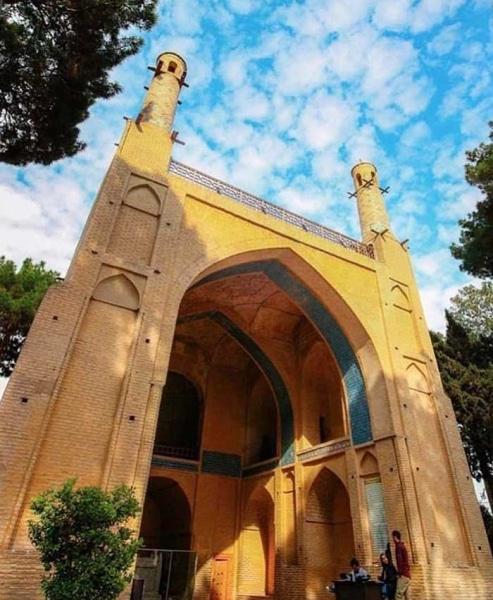
Removed from Unnamed collection
Menar Jonban 
Menar Jonban (meaning: Shaking Minarets) is a historic monument in Isfahan city. While the monument dates back to 14th century as a shrine for a Sufi hermit, the shaking minarets are believed to have been built in the Safavid Era (1501-17036).
An anti-earthquake monument is considered as one historical, architectural and scientific site in Iran and is one of the famous sites of the world, and of the top Isfahan tourist attractions.
The reason to name this monument Menar Jonban (Shaking Minarets) is that in spite of the building’s firmness, it shakes in its place. The minarets were shaking every hour for the past few hundred years and are still standing. The major distinguishing feature of the monument is that whenever one minaret is shaking, the other also shakes, along with the whole building and Menar Jonban Isfahan, gets its uniqueness from this feature. https://irantourismer.com/menar-jonban-isfahan/
Map
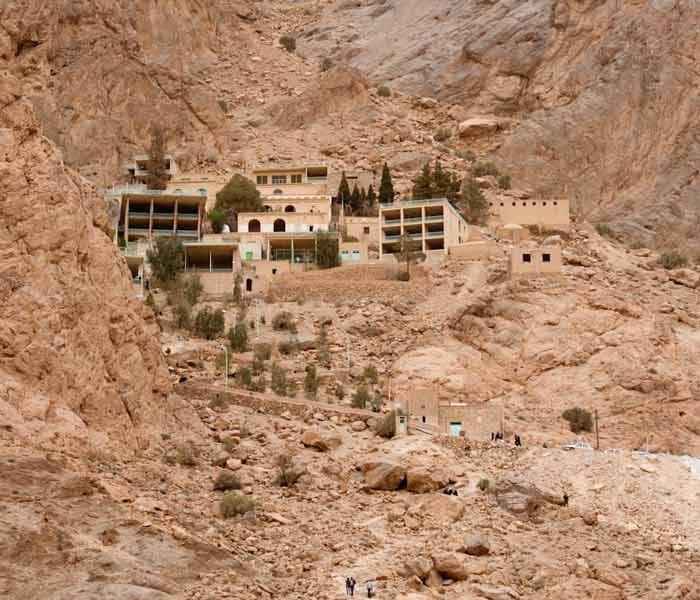
Removed from Unnamed collection
Chak Chak Village 
Chak Chak Village is located in Ardakan County, 70 km north of Yazd city. The temple of Chak Chak is perched beneath a cliff, which is one of the holy Zoroastrian mountain temples in Iran when the avid Zoroastrians gather on special occasions to observe their rituals. While the temple is a man-made grotto in the cliff, historical beliefs and legends shrouds the sanctuary.
The mystery of the history of Chak Chak Village is a folklore legend as it goes: After the invasion of Arabs to the realm of Sassanid Dynasty and the defeat of the last king, Yazdegerd III, the royal family took refuge in the current city of Yazd. By the time Arabs conquered Yazd, the family separated to increase the chance of survival.
One of Yazdegerd’s daughters, Nikbanu, flees to the Ardakan mountain and Chak Chak Village. And prays to Ahura Mazda (what Zoroastrians call The God) to protect her from Arabs. In response of her sincere supplication, Ahura Mazda commanded the mountain to be opened and safe haven for the chaste lady. https://irantourismer.com/chak-chak-yazd-pir-e-sabz/
Map
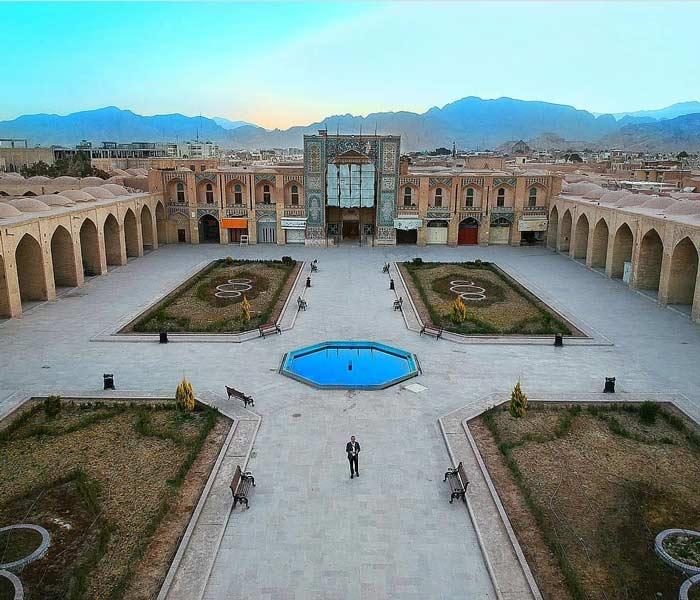
Removed from Unnamed collection
The Grand Bazaar of Kerman 
Kerman Bazaar is a captivating gem in Iran, renowned for its stunning architecture and rich history. It dates back six centuries and stands as one of the main attractions in Kerman. Nestled in the city's old district, this bustling marketplace stretches an impressive 1,200 meters from Arg Square, also known as Tohid, to Moshtaghieh Square, or Shohada. The Grand Bazaar of Kerman holds the title of Iran's longest market, with a multitude of bazaars branching off in various directions. Historically, Kerman Bazaar was strategically positioned along key trade routes like the ancient Silk Road. This location made it a vital link between the southern ports, northern and eastern cities, and desert towns. Its economic significance was undeniable. As one of Iran's oldest trading hubs, Kerman Bazaar is a fascinating complex of historical monuments, crafted over different eras by various rulers of Kerman. This includes more than 60 percent of historical sites, such as schools, mosques, and bathhouses. Beyond its historical allure, the bazaar is a sensory delight. The air is filled with the enticing aroma of spices, and the vibrant colors of Persian rugs and textiles catch the eye at every turn. Friendly vendors offer a warm welcome, often inviting you to sit and enjoy a cup of tea as you explore their wares. This engaging atmosphere makes it easy to lose track of time while wandering through its lively corridors.
Map
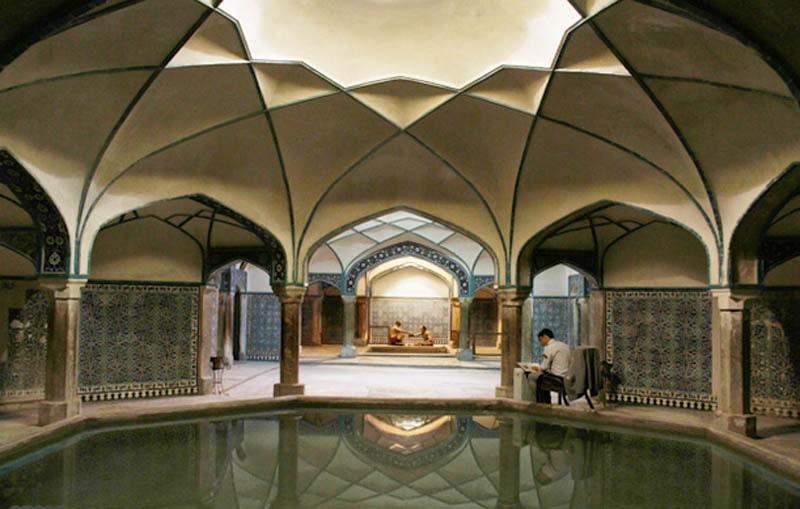
Removed from Unnamed collection
Ganjalikhan Bathhouse 
Imagine stepping into a living masterpiece of art and architecture: that's exactly what you experience at Ganjali Khan Bathhouse. Nestled in the heart of the Ganjali Khan Complex, this bathhouse is a testament to the genius of its architect, Ostad Mohammad Soltani from Yazd. He had a remarkable understanding of the political, economic, and cultural nuances of his era, which is vividly reflected in the design of the complex. The bathhouse is a visual feast with its stunning tile work, intricate paintings, and exquisite plasterwork that captivate every visitor's eye. Bathhouses like Ganjali Khan have been an integral part of city infrastructure, especially in Islamic cities and villages, serving not just as places for cleansing but as social hubs. The entrance to this particular bathhouse is seamlessly integrated into the Ganjali Khan Bazaar, making it a convenient and prominent feature of the area. As you pass through the entryway, you're greeted by mesmerizing paintings from the Safavid era, setting the stage for what's to come. The bathhouse itself stretches 64 meters in length and 30 meters in width, covering a substantial area of about 1,380 square meters. The hot chamber, or Garmkhane, measures 6.25 meters in length and 7.5 meters in width, while the reservoir spans 8.5 meters by 5.7 meters, creating a cozy and intimate atmosphere. The bathhouse is thoughtfully divided into two main sections: the hot chamber and the dressing room. The dressing room is particularly fascinating, with six chambers each dedicated to different social classes of the Safavid era. These classes ranged from Sayeds and clergy to tribal chiefs, merchants, and rustics. Today, statues in each chamber bring these historical social distinctions to life, offering a glimpse into the past. Beyond its historical and cultural significance, the Ganjali Khan Bathhouse is a marvel of design and functionality, illustrating how architecture can tell stories and preserve history. It's a must-visit for anyone interested in the rich tapestry of Iranian culture and history.
Map
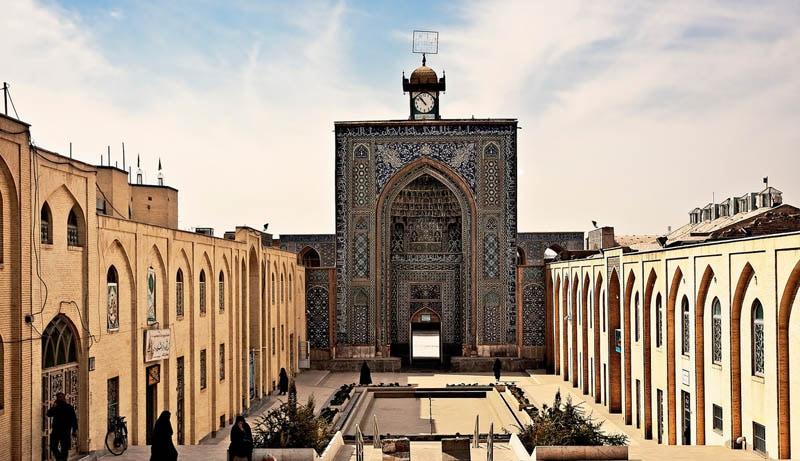
Removed from Unnamed collection
Jame Mosque 
The Jame Mosque, built in the 14th century, stands as a historic gem and the heart of prayer for Muslims in Kerman. Positioned strategically at the city's center, it nestles at the crossroads of Qadamgah Bazaar to the south, Shariati Street to the north, and Shohada (Moshtaqie) Square to the east. This prime location made it a bustling hub of activity and spirituality. On the western side, the mosque boasts an impressive and towering portal adorned with exquisite tile work that captivates visitors with its intricate beauty. This architectural marvel also features expansive porches designed for both summer and winter use, ensuring comfort for worshippers year-round. To the west, you'll find the Mahdieh building, adding to the site's historical allure. Interestingly, some of the shops in the Qadamgah and Mozafari Bazaars have dedicated their income to support the mosque's upkeep, a testament to the community's reverence for this sacred place. Kerman itself is a city rich in history and culture, offering travelers a unique blend of ancient traditions and modern life. The Jame Mosque is just one of the many intriguing sites to explore, with its artful architecture and vibrant atmosphere. Take a moment to wander through the nearby bazaars, where the scent of spices fills the air and the colorful stalls beckon with their treasures. This is a place where the past and present coexist harmoniously, inviting you to discover its stories and secrets.
Map

Removed from Unnamed collection
Abyaneh Village 
Abyaneh village is situated on the slopes of Karkass Mountain in Natanz County of Isfahan Province. With a population of 301 (2016 census), the history of Abyaneh village dates back to 1500 years ago, making it one of the top attractions of Isfahan, and one of the unique villages of Iran, for its peculiar reddish hue.
Most famed for its peculiar red hue and nature-adapted layout, Abyaneh village attracts thousands of Iranian and foreign tourists year-round. However, there is more to Abyaneh red village than meets the eye, which is why it was listed as one of Iran’s national heritage sites in 1975.
According to a 2016 census, the population of Abyaneh village was 301. People mostly subsist on agriculture (including orchards) and raising cattle; While rug weaving workshops and making traditional Giveh shoes are a source of income for the villagers too. Needless to say that tourism is an ever-growing industry for Abyaneh historical village. https://irantourismer.com/abyaneh-village/
Map
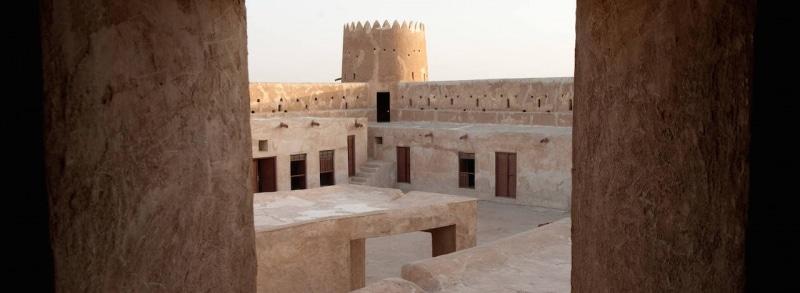
Removed from Unnamed collection
Al Zubarah 
Located on Qatar’s north-west coast and comprising the immaculately restored Al Zubarah Fort and surrounding 60-hectare archaeological works, this UNESCO World Heritage site is one of the most extensive and best preserved examples of an 18th–19th century settlement in the region. https://www.visitqatar.qa/discover/tourist-hotspots/al-zubarah.html
Map
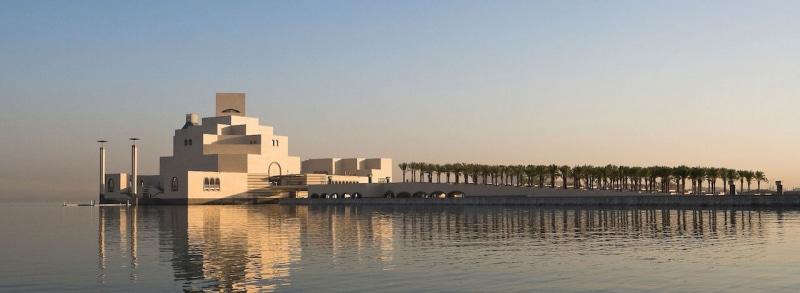
Removed from Unnamed collection
Museum of Islamic Art 
xperience 14 centuries of great art in a few hours. The MIA’s magnificent and imaginatively presented displays of the finest art and artefacts from across the Islamic world have earned it recognition among the world’s top cultural institutions. https://www.visitqatar.qa/discover/tourist-hotspots/museum-of-islamic-art.html
Map
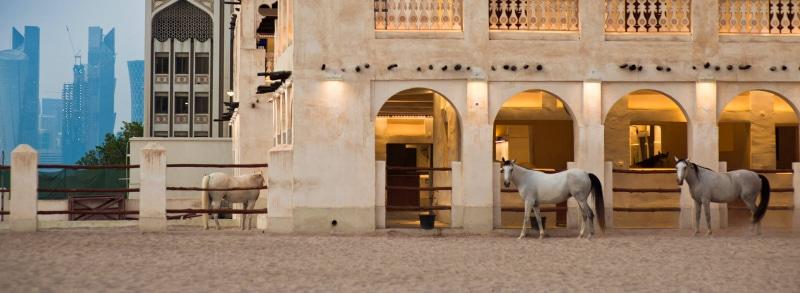
Removed from Unnamed collection
Souq Waqif 
A stroll down the bustling alleys of Souq Waqif provides an authentic taste of traditional commerce, architecture and culture. The maze of small shops offer a dazzling array of Middle Eastern merchandise from spices and seasonal delicacies to perfumes, jewellery, clothing, handicrafts and a treasure trove of souvenir bargains. https://www.visitqatar.qa/discover/tourist-hotspots/souq-waqif.html
Map

Removed from Unnamed collection
Fin Garden 
Fin Garden is located on the western end of Kashan city. Fin Garden (Bagh-e fin) is the oldest existing Persian Garden in Iran. Built in 1590 by the order of the Safavid king, Shah Abbas I, the garden was expanded in early Qajar era (late 18th century). It counts as one of the most important Kashan tourist attractions.
Fin garden is a UNESCO world heritage site since 2011, along with 8 other Persian Gardens in Iran.
Fin Garden architecture is a perfect sample of Iranian Gardens and a mixture of architectural features from Safavid era, Zandiyeh and Qajar periods. There was symmetry applying on the garden plan, but later the addition of the buildings by the kings led to its plan’s symmetry decrease. https://irantourismer.com/fin-garden-kashan-bagh-e-fin/
Map
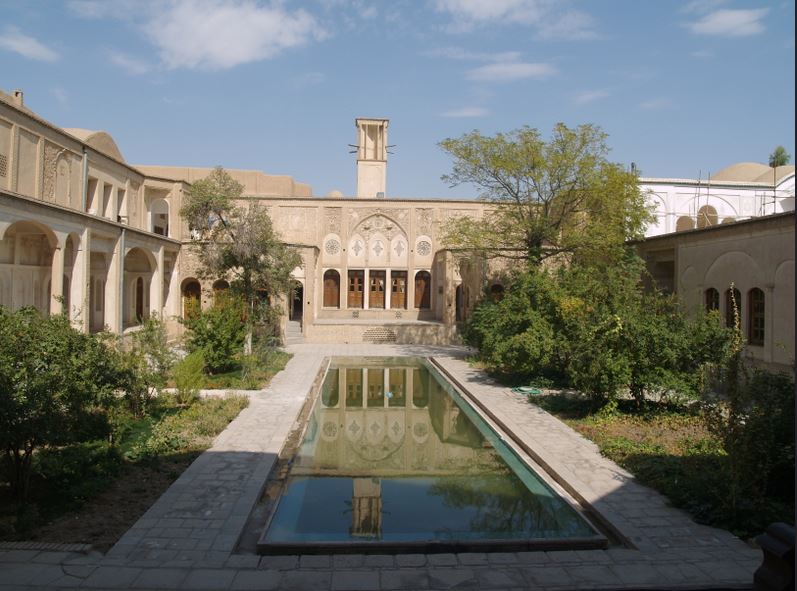
Removed from Unnamed collection
Borujerdi House 
Borujerdi House is a traditional historic house in Kashan city of Isfahan Province. It was built in 1857 by the same architect who built the exquisite house nearby (Tabatabaei House), for its affluent merchant owner, Seyed Mehdi Natanzi. Borujerdi House is a brilliant example of vernacular architecture of the desert region of Iran. The house counts as one of the top Kashan tourist attractions.
Owner of Boroujerdi House Kashan (Borujerdi House), Seyed Mehdi Natanzi a wealthy merchant of Natanz known as Boroujerdi, fell in love with Seyed Jafar Tabatabaei’s daughter (one of the greatest carpet merchants of the time). In order to give him his consent to marry his daughter, he asked Seyed Mehdi Natanzi to build a house similar to his own house!
And he did so! to satisfy the demand of his future bride’s family. After seven years the construction of Andaruni yard (interior yard) and after 11 years the main hall were completed! https://irantourismer.com/boroujerdi-house-kashan-borujerdi-house/
Map
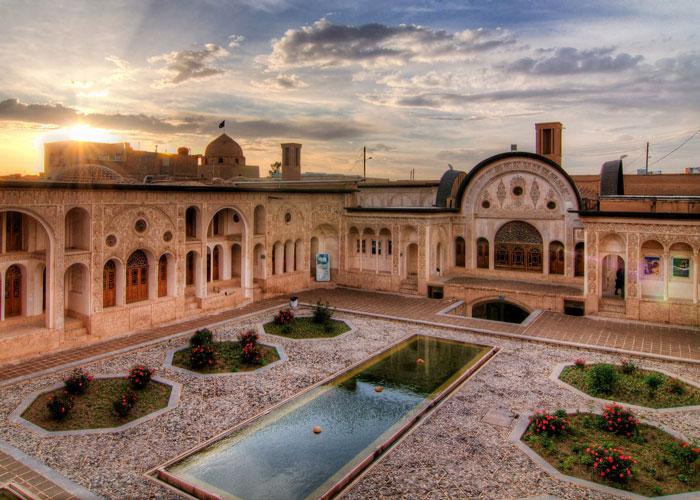
Removed from Unnamed collection
Tabatabaei House 
Tabatabaei House is a historic traditional house in the city of Kashan. Built in 1835, the house belonged to the affluent Tabatabaei family. The house measures 5,000 sqm and includes 40 rooms. Tabatabaei Historical House is the quintessential example of Iranian climate-adaptive vernacular architecture.
Tabatabaei House in Kashan is also known as “the bride” among all other traditional Houses. The reason behind this naming is the fact that the delicate beauty visible to the visitors of the mansion is one of a merit kind!
Tabatabaei Historical House is one of the well-preserved original Persian mansions of Iran. You will be astonished with the details of the Tabatabaei House architecture. Tabatabaei House in Kashan along with a couple of other mansions are the most visited Kashan attractions. Tabataba’iha House is occasionally used in the production of films portraying the old Iran. https://irantourismer.com/tabatabaei-house/
Map
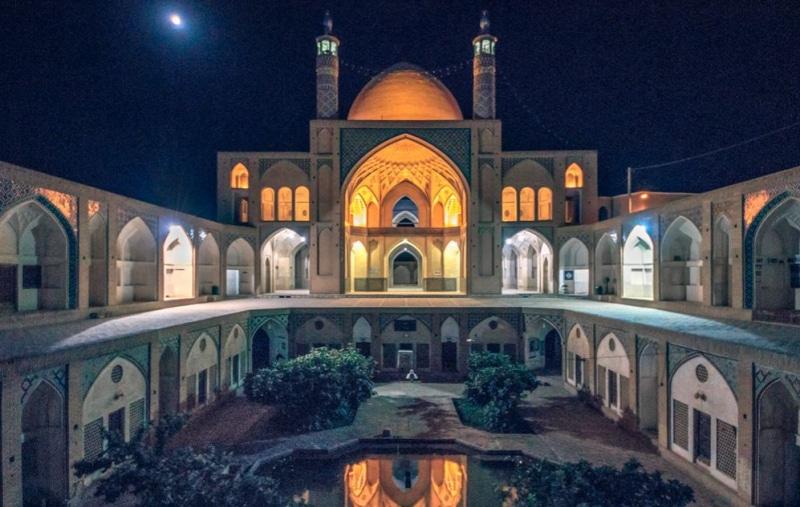
Removed from Unnamed collection
Agha Bozorg Mosque 
Agha Bozorg Mosque is a historic mosque in Kashan city. Constructed in the late 18th century (Qajar era). Aqa Bozorg Mosque and theological school were dedicated to Molla Mahdi Naraghi II (titled Agha Bozorg or the great lord), a prominent clergy of the time, to perform praying, preaching and teaching. The mosque counts as one of the unique Kashan attractions.
Agha Bozorg Mosque architecture makes the monument truly unique among Iranian mosques, for its vernacular architecture and adaptation to the desert climate with such finesse and aesthetic taste.
Aqa Bozorg Mosque Kashan is still a working mosque and open to both students and the public. One of the finest Islamic complexes and best of the mid-19th century. https://irantourismer.com/agha-bozorg-mosque-kashan-aqa-bozorg/
Map

Removed from Unnamed collection
Sharjah Islamic Museum 
Sharjah Museum of Islamic Civilization features seven galleries spread over two levels. The ground-floor galleries cover aspects of the Islamic faith and the achievements of Arab scientists and astronomers. The upper floors offer a chronological overview of Islamic arts and crafts, including textiles and jewellery.
Housed in building every bit as impressive as its collection, the museum is located on the Corniche, just north of the Heart of Sharjah district.
Astrolabes, manuscripts, ceramics and coins all vie for your attention but don’t miss the gold-embroidered curtain for the door of the Holy Ka’ba and the mosaic inside the central dome detailing the zodiac constellations. https://www.visitsharjah.com/activities/culture/sharjah-islamic-museum/
Map
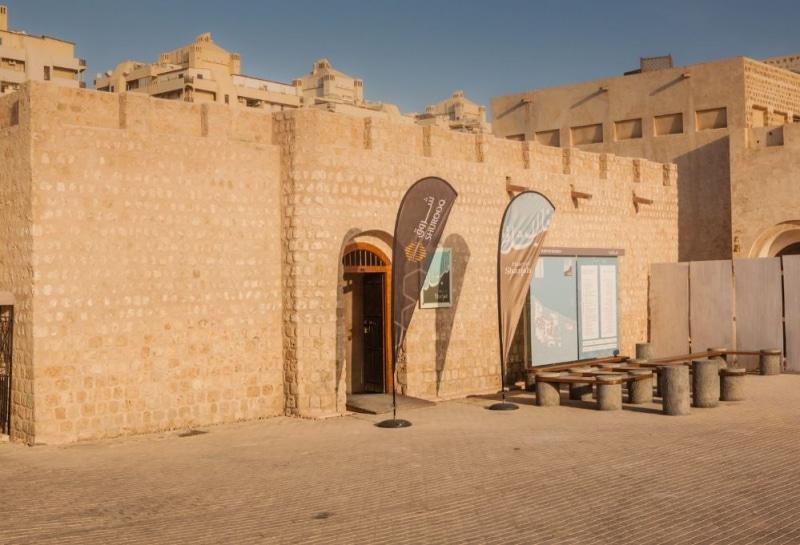
Removed from Unnamed collection
Sharjah Heritage Museum 
Set in a restored 18th-century pearl merchant’s house, Sharjah Heritage Museum explores all aspects of Emirati culture, from religious traditions to living in the desert. There are six galleries covering the landscape, lifestyle, celebrations, livelihoods, traditional knowledge and oral traditions of the emirate.
The museum presents plenty of interesting objects, including an aftakh – a golden toe ring worn by Bedouin women – with explanations in English and Arabic. Younger visitors will enjoy the engaging folk tales, proverbs and puzzles. https://www.visitsharjah.com/activities/heritage/sharjah-heritage-museum/
Map
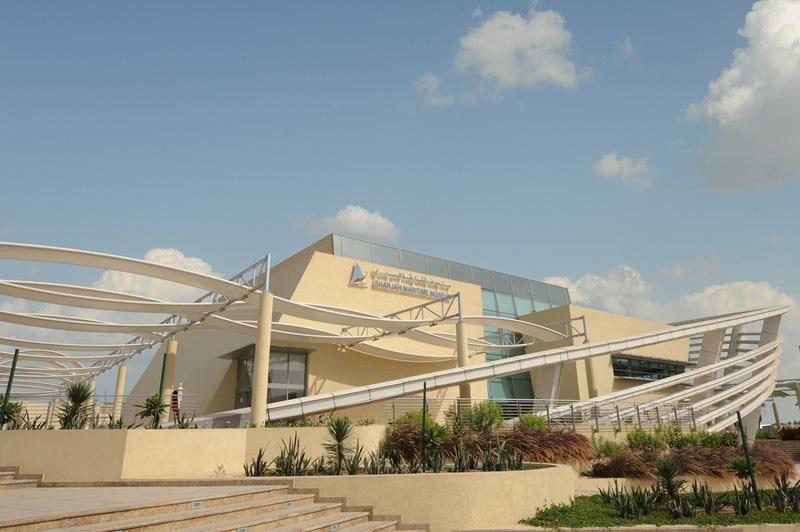
Removed from Unnamed collection
Sharjah Maritime Museum 
The Sharjah Maritime Museum first opened its doors in the Heritage Area back in early 2003, aiming to showcase the UAE's rich maritime history. Recognizing the sea's profound impact on the region's culture and traditions, the museum found a new home in Al Khan in 2009, expanding its exhibits and offerings. This location is perfect for immersing oneself in the maritime legacy, with displays that include traditional wooden dhows and fascinating artifacts that tell the tales of seafaring life. Visitors will find themselves lost in stories of pearl diving and fishing, activities that were once the backbone of the local economy. The museum's collection is a treasure trove for those curious about the region's connection to the sea. It's a great spot to learn about the traditional practices and innovations that have shaped the UAE's relationship with the ocean. Nearby, Al Khan offers beautiful coastal views and a chance to see the modern side of Sharjah, where the past and present blend seamlessly.
Map
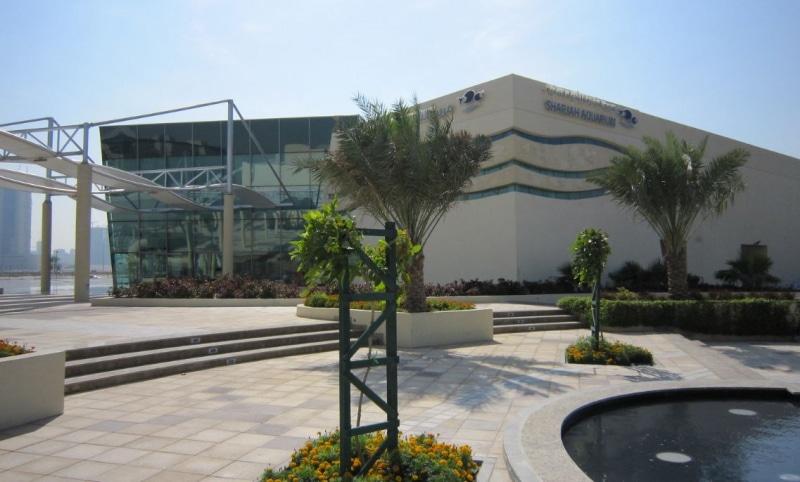
Removed from Unnamed collection
Sharjah Aquarium 
Sharjah Aquarium features 20 tanks that recreate different local aquatic environments, from coral reefs and rock pools to lagoons and mangroves. An indoor walkway allows up-close viewing of the marine animals in these habitats.
For a family experience, try timing your visit with a scheduled fish feeding time or talk. Children will be delighted to learn more about the sea creatures and play on the interactive displays. The aquarium should be on the top of any list of things to with kids in Sharjah, especially for children’s edutainment. Families in Sharjah often bring kids here to learn about local marine life.
If you’re planning the aquarium as one of your places to visit in Sharjah at night, make sure to catch the sunset at the beautiful Al Khan beach first. The views here are as beautiful but distinctively different from the Sharjah Corniche. Then, take a quick tour of the aquarium before it closes in the late evening. Your ticket includes entry to the Sharjah Maritime Museum next door, where you can learn about the coast in more detail than any other Sharjah museum. After visiting these destinations, you will have checked off three popular Sharjah tourist places. https://www.visitsharjah.com/activities/wildlife/sharjah-aquarium/
Map
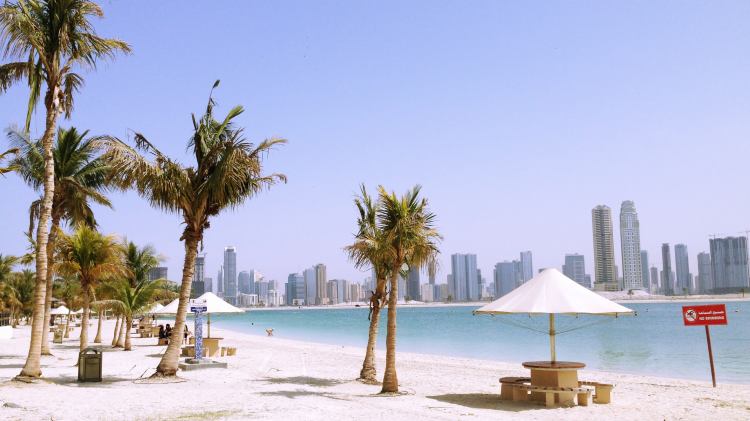
Removed from Unnamed collection
Al Mamzar Beach Park 
Al Mamzar Beach Park is one of those delightful spots in Dubai that locals love to frequent. Spanning a whopping 106 hectares, it sits right next to Mamzar Beach, close to Hamriya Port and Deira. The area boasts five distinct beaches that beautifully encircle the park, offering a slice of paradise for everyone. With a plethora of family-friendly facilities and activities, it's a haven for kids and adults alike. Imagine spending a sunny afternoon indulging in a picnic on the lush grassy areas or grilling up a feast at one of the many public barbecue stations. With convenient changing rooms, pristine beaches, and refreshing pools, the park has everything you need for a relaxed day out. Lifeguards keep a watchful eye on the kid-friendly swimming zones, ensuring safety is a top priority. For a unique perspective, settle by the serene lagoon, or if you're feeling adventurous, hop aboard the charming Park Train. This nifty ride offers a fun way to explore the entire park, keeping the little ones entertained. Adding to its allure, the park features a musical amphitheater where performances occasionally light up the stage, offering a delightful cultural experience. Whether you're planning a quick escape or an all-day adventure, Al Mamzar Beach Park promises a memorable outing. Just a short drive past the iconic Dubai Creek, it's the perfect spot for a leisurely picnic or an exciting family day out. Fun fact: the park also offers rental cabins and air-conditioned chalets for those who want to extend their stay and enjoy a night under the stars.
Map
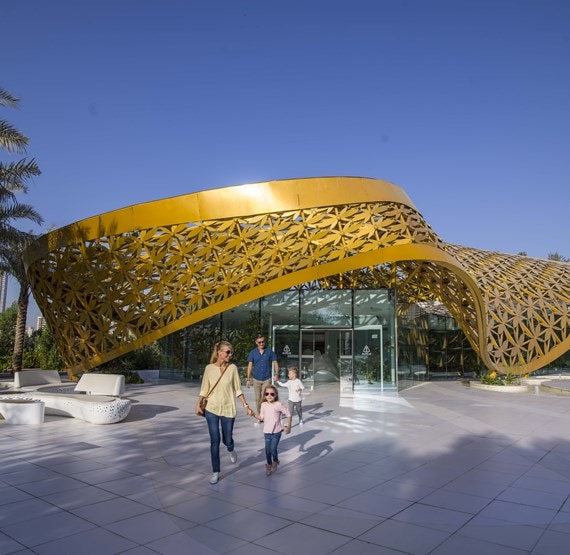
Removed from Unnamed collection
Al Noor Island Butterfly House 
Over 500 butterflies live on Al Noor Island in the Butterfly House, one of the most popular tourist places in Sharjah. The Butterfly House itself is a feat of modern architecture, with the outdoor structure made of perforated steel and ergonomic design to let in sunlight. With temperature and humidity controlled interiors, the structure houses over 20 different species of butterflies, including the exotic Tailed Jay, Emerald Swallowtail, Pink Rose and Malachite. The house also has comprehensive information on the region’s native species. This destination has many fun things to do with kids in Sharjah, with a dedicated children’s area and an array of butterflies in different shapes, colours and sizes. Trying to spot camouflaged butterflies and watching newborns take flight is arguably among Sharjah’s most exciting summer activities for kids.
To reach the Butterfly House, take the bridge to the island, which is just right across the water from the Al Noor Mosque; among the most striking Sharjah landmarks. Tour the displays of thought-provoking contemporary art and sculpture pieces. Then follow the boardwalk through a tropical botanical garden, one of the popular parks in Sharjah, and you’ll find the Butterfly House. It is hard to miss with the uniquely shaped steel glistening in the sunlight. End the day with a meal and drink at the organic cafe and find the perfect souvenir to take home. https://www.visitsharjah.com/activities/wildlife/al-noor-island-butterfly-house/
Map
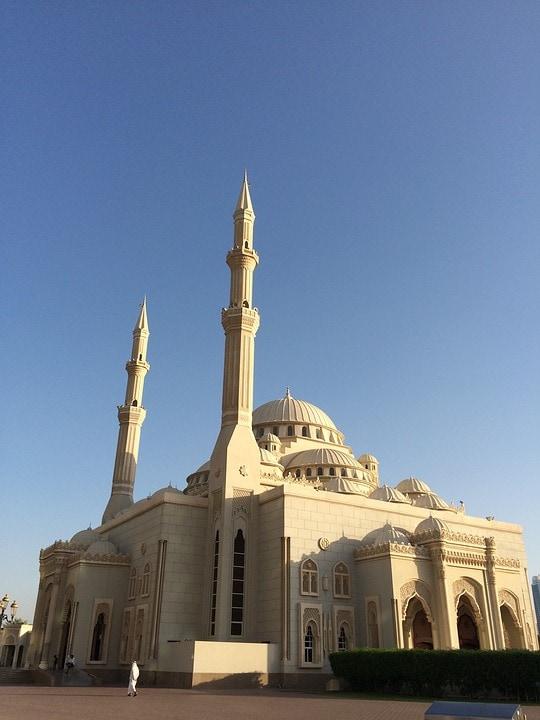
Removed from Unnamed collection
Al Noor Mosque 
Opened in 2005, Al Noor Mosque was commissioned by Her Highness Sheikha Jawaher Bint Mohammed Al Qasimi, the wife of His Highness Sheikh Dr. Sultan Bin Mohammed Al Qasimi, Supreme Council Member and Ruler of Sharjah. This architectural gem stands along the picturesque Khalid Lagoon, offering stunning views that are perfect for a reflective afternoon stroll. The mosque's design is a modern take on traditional Ottoman architecture, making it a must-visit for those interested in both history and aesthetics. Guided tours are available, providing insights into the mosque's cultural significance and its unique architectural features. Don't miss the chance to witness the beautiful calligraphy and intricate patterns that adorn its walls. Whether you're exploring Sharjah for the first time or a returning visitor, Al Noor Mosque promises a captivating peek into the city's rich heritage.
Map
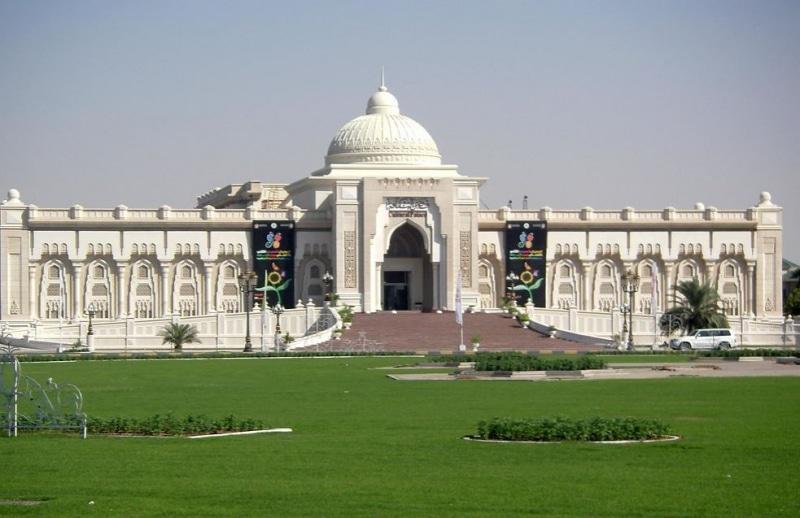
Removed from Unnamed collection
Cultural Square 
The Cultural Square features a 14-metre high pedestal with a sculpture of the Holy Quran. It is the centrepiece of the roundabout in the square, representing the spiritual heart of the city. The sculpture, which was designed by Spanish sculptor Marinas Rubias, is encircled by a number of stately buildings in typical Islamic architecture. These Sharjah buildings are of prominence in UAE history, particularly the Ruler’s Office and the Ahmad Bin Hanbal Mosque. Also in the square is the Cultural Palace, a place for concerts and events.
When you’re in Sharjah next, make sure to drive by the cultural square. It is a key highlight of the many tourist places in Sharjah. Since the sculpture is at a roundabout, you can easily drive by it more than once. If you’re thinking of things to do with kids here, they will enjoy going around a few times in your car. Cultural Square is one of the popular places to visit in Sharjah with children, especially to learn about Islamic art. https://www.visitsharjah.com/activities/culture/cultural-square/
Map
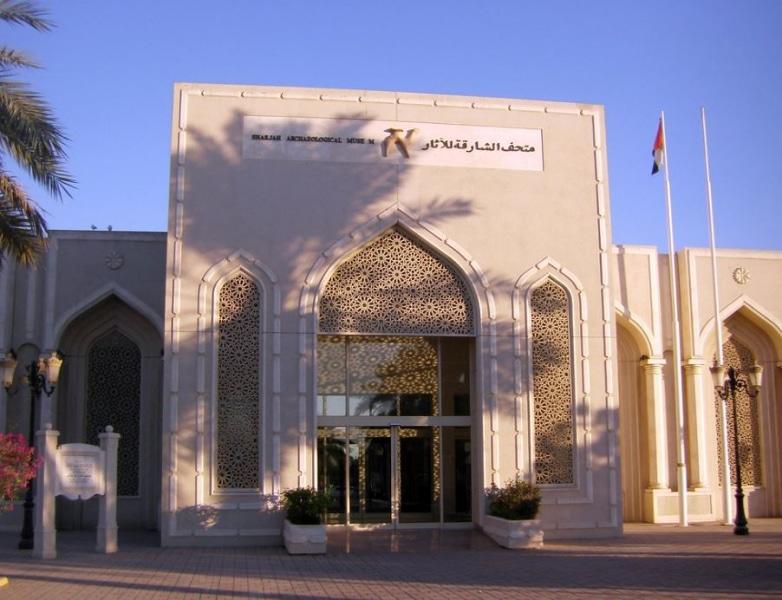
Removed from Unnamed collection
Sharjah Archeological Museum 
With a treasure trove of pottery, jewellery and weaponry on display, this Sharjah museum uncovers the daily life of ancient inhabitants in the region, far before modern UAE culture. The most significant discoveries in the country are featured in this museum, including a 2,000-year-old golden bridle from Mleiha, findings from a Stone Age graveyard with the skeletons of 500 nomadic herders and a vast collection of Arabic art. For history buffs, this is one of the most important tourist places in Sharjah.
For things to do with kids, head to the children’s area which features interactive displays, informative exhibits and films. Call ahead of time to plan your trip during the museum’s summer activities for kids. To get to the museum, take a Sharjah bus with a stop on the Sharjah bus route close by. Or, reach there quicker with a Sharjah taxi. https://www.visitsharjah.com/activities/heritage/sharjah-archaeology-museum/
Map


